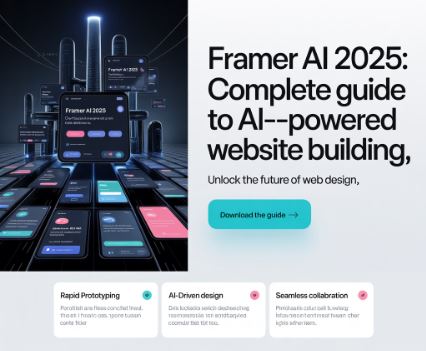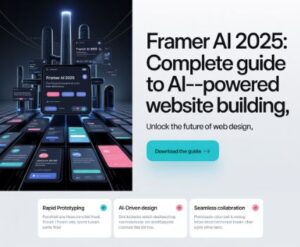Framer AI 2025: Complete Guide to AI-Powered Website Building
October 04, 2025 | Gudstory Org AI News
The landscape of website creation has fundamentally shifted in 2025. Traditional coding barriers are dissolving as artificial intelligence takes center stage in digital design. Among the platforms leading this revolution, Framer AI has emerged as a game-changing solution for creators seeking professional web presence without technical complexity.
Understanding Framer AI’s Core Technology
Framer AI represents a sophisticated evolution in web design platforms. Unlike conventional website builders, it leverages natural language processing to transform simple text descriptions into fully-realized web designs. Users communicate their vision through conversational prompts, and the platform’s intelligence interprets these requests to generate complete website structures, visual aesthetics, and content layouts.
What began as a designer-focused prototyping tool has matured into a comprehensive no-code platform. This transformation positions Framer AI as a bridge between creative vision and technical execution, accessible to both seasoned professionals and complete beginners.
Revolutionary Features Powering Modern Web Design
Intelligent Design Generation
The platform’s standout capability lies in its AI-driven website generator. Through advanced language understanding, Framer AI processes user descriptions and produces professional-quality layouts within seconds. Whether you’re building a photographer’s showcase or a business landing page, the system adapts its output to match your specific requirements.
Visual Editing Without Code Barriers
Complete customization remains accessible through an intuitive drag-and-drop interface. Typography, motion effects, element spacing, and navigation structures can all be modified precisely without touching code. This approach maintains professional-grade control while eliminating technical prerequisites.
Search Engine Visibility Built-In
Modern websites require more than attractive design—they need discoverability. Framer AI addresses this through integrated search optimization features. The platform automatically generates appropriate meta information, produces clean underlying code, and optimizes loading performance. These elements work together to improve ranking potential on major search engines.
Cross-Device Compatibility
Contemporary web users access content across multiple device types. Framer AI’s responsive design engine automatically adapts layouts, imagery, and interface elements for optimal viewing on smartphones, tablets, and desktop computers. This adaptation happens intelligently during the design process.
Team-Based Workflow Support
Design collaboration becomes seamless through real-time multi-user functionality. Teams can simultaneously work on shared projects with instant synchronization. This capability makes the platform particularly valuable for agencies and startups requiring coordinated design efforts.
Content Management Capabilities
Content-driven websites benefit from Framer’s integrated management system. Users can structure blogs, showcase portfolios, or organize product catalogs without external tools. The system prioritizes simplicity while maintaining the power needed for content-rich projects.
Investment and Pricing Structure
Framer AI’s pricing model accommodates various user needs through tiered plans:
Free Tier: Entry-level access with basic AI functionality, suitable for testing and personal experimentation.
Professional Tier: Monthly subscription ranging from $10-$20, unlocking full AI generation, content management, and custom domain support.
Enterprise Tier: Customized pricing for organizations requiring advanced collaboration features and dedicated support.
Compared to traditional web development costs, these price points offer significant economic advantages while delivering professional-quality results.
Competitive Landscape Analysis
When evaluated against alternative no-code platforms, Framer AI distinguishes itself through several key advantages:
AI Integration Depth: While platforms like Wix offer AI features, Framer’s implementation provides more sophisticated automation combined with granular manual control.
Design Flexibility: Unlike template-heavy competitors, Framer balances automated generation with extensive customization options.
Collaboration Infrastructure: Real-time team functionality surpasses offerings from platforms like Squarespace, which lack robust multi-user workflows.
Strategic Advantages for 2025
Accelerated Development Cycles
Time-to-launch becomes dramatically compressed. Complete websites can move from concept to publication within minutes rather than days or weeks.
Enhanced Creative Output
The AI serves as a creative partner, suggesting contemporary design patterns and generating content ideas that users can refine to match their brand identity.
Universal Accessibility
Professional web design becomes democratized. The platform removes technical barriers that historically limited creative professionals, entrepreneurs, and small businesses.
Optimization from Launch
Sites emerge ready for search engine indexing with proper technical foundations already established.
Flexible Scalability
The platform accommodates diverse project types—from simple portfolios to complex business websites—without requiring platform changes as needs evolve.
Considerations and Limitations
Transparency requires acknowledging areas where Framer AI has boundaries:
Backend Complexity: Applications requiring sophisticated server-side logic or custom databases may exceed the platform’s intended scope.
Content Refinement: AI-generated text and copy typically benefit from human review to ensure brand voice consistency and messaging precision.
Initial Learning Investment: While dramatically simpler than coding, new users still face a learning period to master the platform’s full capabilities.
The Broader Impact on Web Creation
Framer AI exemplifies a significant shift in how digital presence gets established. The platform addresses three critical needs simultaneously: speed, quality, and accessibility. By eliminating the traditional developer dependency, it empowers individuals and organizations to iterate rapidly on their web presence.
The platform’s ongoing development suggests continued AI enhancement and expanded user experience refinement. This trajectory positions Framer AI as a defining tool in the evolving no-code movement.
Bottom Line: Making the Investment Decision
For 2025, Framer AI represents an exceptional value proposition for specific user groups. Designers gain a powerful tool for rapid prototyping and client delivery. Marketers obtain the ability to quickly test landing pages and campaigns. Small business owners can establish professional online presence without outsourcing costs.
The synthesis of AI automation, no-code flexibility, and built-in optimization creates a compelling package for modern web creation. For anyone prioritizing speed, visual quality, and independence from developers, Framer AI deserves serious consideration as a primary website building platform.
The future of web design increasingly belongs to tools that make professional creation accessible. Framer AI stands firmly in that future, offering both immediate practical value and a glimpse of where digital creation continues to evolve.


